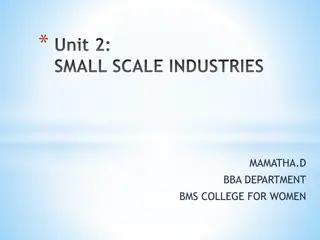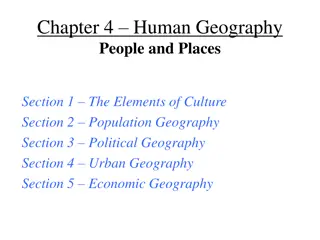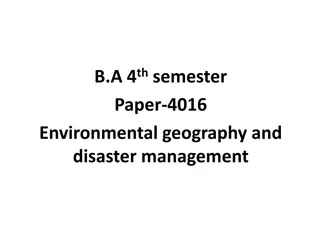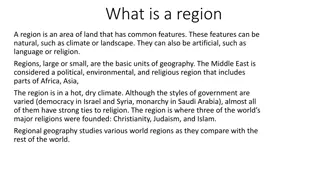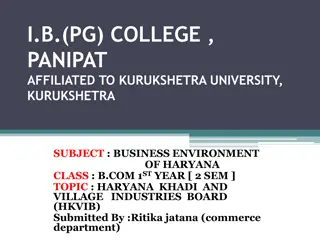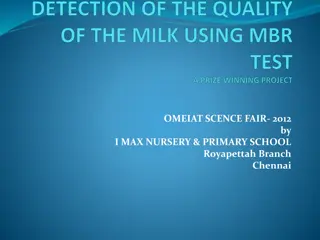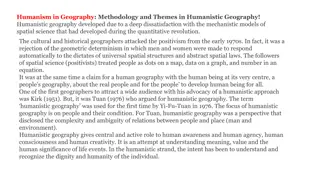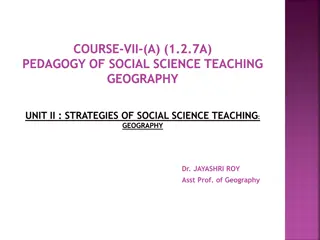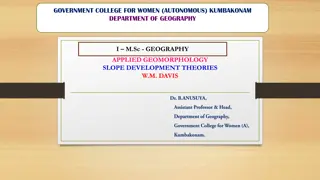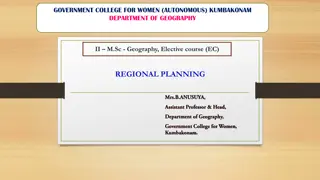Understanding Economic Activities and Industries in Class 8 Geography Test
Economic activities are classified into primary, secondary, and tertiary sectors, with examples provided for each. Shifting cultivation, factors for selecting industrial sites like Sakchi, fiber crop requirements, reasons for agriculture being primary in India, and the significance of the iron and steel industry are discussed.
Download Presentation

Please find below an Image/Link to download the presentation.
The content on the website is provided AS IS for your information and personal use only. It may not be sold, licensed, or shared on other websites without obtaining consent from the author. Download presentation by click this link. If you encounter any issues during the download, it is possible that the publisher has removed the file from their server.
E N D
Presentation Transcript
Geography Test (with solutions) Class 8th: Agriculture and Industries
1. Write a short note on the types of economic activities. Give examples. The three types of economic activities are primary, secondary and tertiary. i. Primary Activities - Activities which involve direct extraction and production of natural resources are called primary activities. Examples: agriculture, mining. ii. Secondary Activities - Activities which are concerned with the processing of natural resources are called secondary activities. Examples: manufacturing of nished products. Tertiary Activities - Activities which fall neither in the primary category nor the secondary category are called tertiary activities. They form a support to primary and secondary activities. Examples: selling goods, advertising and banking. 2. What is shifting cultivation? What are its disadvantages? Shifting cultivation is the form of agriculture in which a plot of land is cleared by felling the trees and burning them. The ashes are then mixed with soil and crops are grown. After some time, the land is abandoned and the farmers move to a different place. It is disadvantageous because it involves deforestation and burning of trees. Thus it is not good for environment. iii.
3. What factors supported Sakchi being chosen to set up the steel plant by TISCO? Sakchi was chosen for various reasons. It was close to the Kalimati Railway Station. It was also close to iron ore, coal and manganese deposits. Kolkata, a source of large market, was not faraway. Jharia coal fields, and limestone, dolomite, limestone and manganese from Orissa and Chhattisgarh were easily accessible. The nearby rivers (Kharkai and Subamarekha) provided sufficient water supply. 4. Name the fibre crops and name the climatic conditions required for their growth. Two major fibre crops are jute and cotton. Jute grows well on alluvial soil and requires high temperature, heavy rainfall and humid climate for its growth. Cotton needs high temperature, light rainfall and bright sunshine for its proper growth.
5. Give reasons. i. In India agriculture is a primary activity. Agriculture is an activity of growing crops, fruits, vegetables, flowers and rearing of livestock. It is a primary activity since it directly involves the natural resources. Due to lack of literacy in general, farmers prefer agriculture since they acquire the required skills from their ancestors, and so feel comfortable with it. ii. Different crops are grown in different regions. The growing of crops depends on a lot of factors. Climate, rainfall, humidity etc. are important factors. In absence of certain conditions, it may not be possible to grow a certain crop. So, different crops are grown in different regions. 6. Which industry is often referred to as the backbone of modern industry and why? The iron and steel industry is referred to as the backbone of modem industry. This is so because it is a feeder industry whose products are used as raw materials for other industries.
7. Distinguish between the following. (i) Primary activities and tertiary activities S. No. 1 Primary activity Tertiary activity Activities involve direct extraction of and production through natural resources are called primary activities Examples agriculture, fishing and gathering Activities concerned with the processing of natural resources are called secondary activities Examples manufacturing activities in industry 2 (ii) Subsistence farming and intensive farming S. No. 1 Subsistence farming Intensive farming Subsistence farming uses low level/ old fashioned technology and household labour. The output produced in small In Intensive farming, farmer uses simple tools and more labour to cultivate a small plot of land
8. Distinguish between the following Agro-based and mineral-based industry S. No. 1 Agro-based Industry Mineral-based industry Use plant and animal based products as raw materials Use mineral ores as raw materials 2 Examples of raw material animal skin, crops Examples of raw material iron ore, limestone 3 Examples of industries leather industry, food processing Examples of industries iron and steel industry Public-sector and joint-sector industry S. No. 1 Public Sector Industry Joint Sector industry Owned and run by government Owned and operated by state as well as individuals 2 Example Hindustan Aeronautics Limited Example Maruti Udyog
9. Describe briefly the classification of industries on basis of ownership. On the basis of ownership, industries are classified into private sector, state owned (public sector), joint sector and cooperative sector. Private sector industries are owned by individuals or a group of individuals. Public sector industries are owned by the government. Joint sector industries are owned and operated by the state and individuals. Maruti Udyog is an example of such an industry. Cooperative sector industries are owned and operated by the producers or- suppliers of raw materials, workers or both. AMUL is one such industry.
10.Describe subsistence farming and its types in detail. Subsistence farming is practiced solely to meet the needs of the farmer s family. Therefore, the practices involved are usually old- fashioned. Use of modern technology is minimum and most work is done by household labour. It has two sub-types: i. Intensive Subsistence Agriculture - In intensive, subsistence agriculture, simple tools and huge labour are used by a farmer to cultivate a small plot of land. More than one crop is grown annually in favourable conditions. Rice is the major crop. This form of agriculture is seen in the thickly populated areas of the monsoon regions of south, south-east and east Asia. ii. Primitive Subsistence Agriculture Shifting cultivation - Shifting cultivation is a class of primitive subsistence agriculture. In this, a plot of land is cleared by felling the trees and burning them. The ashes are then mixed with soil and crops are grown. After some time, the land is abandoned and the farmers move to a different place. This type of farming is common in thickly forested areas of Amazon basin, tropical Africa, parts of South-east Asia and north-east India . It is also called Slash and Burn agriculture. Nomadic Herding Nomadic Herding refers to the practice in which herdsmen move from place to place with their animals for fodder and water. Animals usually reared are yak, sheep, camel and goat.







